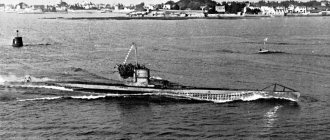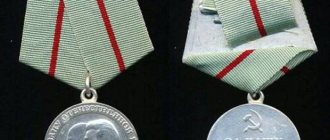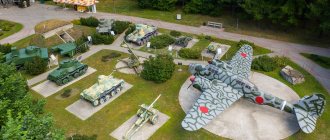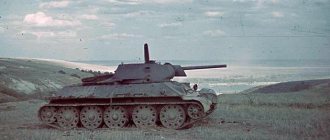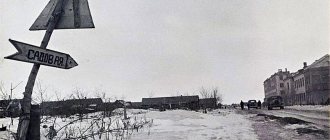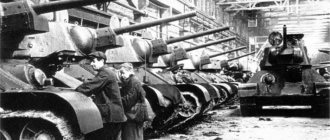History of invention
The primacy of the use of tanks belongs to the British; their use of tanks in the First World War forced military leaders of all countries to reconsider the concept of warfare. The use by the French of their Renault FT17 light tank determined the classic use of tanks for solving tactical problems, and the tank itself became the embodiment of the canons of tank building.
Although the laurels of first use did not go to the Russians, the invention of the tank itself, in its classical sense, belongs to our compatriots. In 1915 V.D. Mendeleev (the son of a famous scientist) sent a project for an armored self-propelled vehicle on two tracks with artillery weapons to the technical department of the Russian Army. But for unknown reasons, things did not go beyond design work.
The idea itself of installing a steam engine on a caterpillar propulsion device was not new; it was first implemented in 1878 by Russian designer Fyodor Blinov. The invention was called: “A car with endless flights for transporting goods.” In this “car”, a track turning device was used for the first time. The invention of a caterpillar propulsion device, by the way, also belongs to the Russian staff captain D. Zagryazhsky. For which a corresponding patent was issued in 1937.
The world's first tracked combat vehicle is also Russian. In May 1915, tests of the armored vehicle D.I. took place near Riga. Porokhovshchikov called “All-terrain vehicle”. It had an armored body, one wide track and a machine gun in a rotating turret. The tests were considered very successful, but due to the approaching Germans, further tests had to be postponed, and after some time they were completely forgotten.
In the same year, 1915, tests were carried out on a machine designed by the head of the experimental laboratory of the military department, Captain Lebedenko. The 40-ton unit was an artillery carriage enlarged to gigantic proportions, driven by two Maybach engines from a downed airship. The front wheels had a diameter of 9 meters. According to the creators, a vehicle of this design should easily overcome ditches and trenches, but during testing it got stuck immediately after it started moving. Where it stood for many years until it was cut up for scrap metal.
Tank Panzerkampfwagen VI Ausf. H1 "Tiger"
"Tiger" was created with one purpose - to crush any enemy and send him into a stampede. Hitler himself personally ordered that the new tank be covered with a frontal armor plate 100 millimeters thick. And the stern and sides of the Tiger were covered with 80 millimeters of armor. The main “trump card” of the combat vehicle was the weapon - this is the 88 mm KwK 36 cannon, created on the basis of the anti-aircraft gun. The gun was distinguished by its consistency of hits and also a record rate of fire. Even in combat conditions, the KwK 36 could “spit” shells as many as 8 times in a minute.
Panzerkampfwagen VI Ausf. H1, "Tiger". Source: wikipedia.org
In addition, the Tiger was another one of the fastest tanks of that time. It was driven by a 700 hp Maybach power unit. With. It was kept company by an 8-speed hydromechanical gearbox. And on the chassis the tank could accelerate to 45 km/h.
It is curious that the technical manual contained in each Tiger contained the following inscription: “The tank costs 800,000 Reichsmarks. Keep him safe!". Goebbels believed that the tankers would be proud that they were entrusted with such an expensive toy. But in reality it was often different. The soldiers were panicky that something might happen to the tank.
The first Soviet tank
Russia ended the First World War without its tanks. During the Civil War, tanks from other countries were used. During the battles, some of the tanks passed into the hands of the Red Army, on which the workers’ and peasants’ fighters entered the battle. In 1918, in a battle with French-Greek troops near the village of Berezovskaya, several Reno-FT tanks were captured. They were sent to Moscow to participate in the parade. Lenin’s fiery speech about the need to build our own tanks laid the foundation for Soviet tank building. We decided to release, or rather completely copy, 15 Reno-FT tanks called Tank M (small). On August 31, 1920, the first copy left the workshops of the Krasnoye Sormovo plant in Nizhny Tagil. This day is considered to be the birthday of Soviet tank building.
The young state understood that tanks were very important for waging war, especially since the enemies approaching the borders were already armed with this type of military equipment. The M tank was not put into production due to its particularly expensive production price, so another option was needed. According to the idea that existed in the Red Army at that time, the tank was supposed to support the infantry during an attack, that is, the speed of the tank should not be much higher than the infantry, the weight should allow it to break through the defense line, and the weapons should successfully suppress firing points. Choosing between our own developments and proposals to copy ready-made samples, we chose the option that allowed us to organize the production of tanks in the shortest possible time - copying.
In 1925, the T-18 or MS-1 tank (the first small escort) was launched into mass production; its prototype was the Fiat-3000. Although not entirely successful, the MS-1 became the tank that laid the foundation for Soviet tank building. At his production site, production itself and the coherence of the work of different departments and factories were developed.
Until the early 30s, several of their own models T-19, T-20, T-24 were developed, but due to the lack of special advantages over the T-18, and due to their high cost of production, they did not go into series.
Armament of USSR armored vehicles
| Caliber mm | Caliber length | Pract. shooting soon | Beginning speed m/s | Corner | Breakthrough guarantee | Projectile weight kg | Armor penetration mm | ||||||||
| 50m | 100m | 500m | |||||||||||||
| DT | 7,62 | 80-125 | 840 | ||||||||||||
| DShK | 12,7 | 80 | 830-850 | 16 | |||||||||||
| TNSH | 20 | 82,4 | 200 | 817 | 60° | 20% | 25 | 18 | |||||||
| Caliber mm | Caliber length | Pract. shooting soon | Beginning speed m/s | Projectile weight kg | Armor penetration mm | ||||||||
| penetration guarantee | 100m | 300m | 500m | 1km | 1.5km | 2km | |||||||
| 20K | 45 | 46 | 7-12 | 757 | 80% | 43(60°) 51(90°) | 36(60°) 43(90°) | 31(60°) 38(90°) | 28(60°) 35(90°) | ||||
| KT | 76,2 | 16,5 | 5 | 370 | 6,5 | 31(90°) | 28(90°) | ||||||
| PS-3 | 76,2 | 20,5 | 11-12 | 530 | |||||||||
| L-10 | 76,2 | 26 | 12 | 558 | 50(90°) | ||||||||
| L-11 | 30,5 | 612 | 55(60°) 66(90°) | 49(60°) 60(90°) | 43(60°) 52(90°) | 38(60°) 46(90°) | 34(60°) 41(90°) | ||||||
| F-32 | 76,2 | 31,5 | 3-8 | ||||||||||
| F-34 | 41,6 | 3-8 | 662 / 950 | 6,5 / 3,02 | 20-80% caliber | 89-74(60°) 94-86(90°) | 82-69(60°) 90-81(90°) | 76-62(60°) 84-75(90°) | 71-55(60°) 78-68(90°) | 55-48(60°) 69-62(90°) | |||
| ZIS-5 | 4-8 | sabot | 95(60°) 120(90°) | 75(60°) 90(90°) | 50(60°) 60(90°) | ||||||||
| ZIS-3 | 6 | ||||||||||||
| Caliber mm | Caliber length | Pract. shooting soon | Beginning speed m/s | Projectile weight kg | Armor penetration mm | ||||||||
| penetration guarantee | 500m | 1km | 1.5km | 2km | |||||||||
| ZIS-2 | 57 | 73 | 15-25 | 990 | 3,15 | 85(60°) 100(90°) | 70(60°) 90(90°) | 65(60°) 70(90°) | 55(60°) 65(90°) | ||||
| ZIS-4 | 6-10 | 995 | 20-80% | 89-83(60°) 105-98(90°) | 85-78(60°) 98-90(90°) | 79-73(60°) 90-82(90°) | |||||||
| D-5 | 85 | 51,6 | 5-8 | 792 | 9,2 / 5 | 80% | 90(60°) 105(90°) | 85(60°) 100(90°) | 78(60°) 92(90°) | 72(60°) 85(90°) | |||
| ZIS-S-53 | 85 | 54,6 | 6-10 | 792 | |||||||||
| D-10 | 100 | 53,5 | 4-6 | 880 | 15,88 | 80% | 125(60°) 155(90°) | 110(60°) 135(90°) | 95(60°) 115(90°) | 87(60°) 110(90°) | |||
| ML-30 | 121,9 | cumulative | 100 | ||||||||||
| A-19 | 121,9 | 43,6 | ?-2,2 | 25 | |||||||||
| D-25 | 121,9 | 43 | 1,2-2,5 | 780 | 80% | 122(60°) 152(90°) | 115(60°) 142(90°) | 107(60°) 133(90°) | 97(60°) 122(90°) | ||||
| M-10T | 152,4 | 436 | 40 | high explosive | |||||||||
| ML-20S | 152,4 | 28,8 | ?-2,3 | 600 | 43,6 | 125 | |||||||
| flamethrower KS-24 | 30-40m | |
| flamethrower KS-25 | 9l each | 45-53m |
| flamethrower ATO-41 | 10l each | 60-65m / 90-100m |
| flamethrower ATO-42 | 70m / 100-130m |
Tank battles in the First and Second World Wars
IDENTIFICATION MARKS OF SOVIET TANKS AND SAU
Tanks of the 30-40s - a disease of imitation
Participation in the conflict on the Chinese Federal Railway showed the inadequacy of the first generation tanks for the dynamic development of the battle; the tanks practically did not show themselves in any way; the cavalry did the main work. A faster and more reliable car was needed.
To select the next production model, we went the beaten path and purchased samples abroad. The English Vickers Mk - 6 tons was mass-produced in our country as the T-26, and the Carden-Loyd Mk VI wedge was produced as the T-27.
The T-27, which at first was so tempting to produce due to its low cost, was not produced for long. In 1933, based on the wedge heel, the army adopted the T-37A amphibious tank, with weapons in a rotating turret, and in 1936 - the T-38. In 1940, they created a similar amphibious T-40; the USSR did not produce more amphibious tanks until the 50s.
Another sample was purchased in the USA. Based on the model of J.W. Christie, a whole series of high-speed tanks (BT) was built; their main difference was the combination of two propellers, wheeled and tracked. To move when marching, BTs used wheels; when fighting, they used caterpillars. Such a forced measure was necessary due to the poor operational capabilities of the tracks, only 1000 km.
BT tanks, developing quite high speeds on the roads, fully suited the changed military concept of the Red Army: breaking through the defense and quickly deploying a deep attack through the resulting gap. The three-turreted T-28 was developed directly for the breakthrough, the prototype of which was the English Vickers 16-ton. Another breakthrough tank was supposed to be the T-35, similar to the English five-turret heavy tank “Independent”.
During the pre-war decade, many interesting tank designs were created that did not go into production. For example, based on the T-26, the AT-1 semi-closed self-propelled gun (artillery tank). During the Second World War, they will again remember these cars without a cabin roof.
Tanks of the Second World War
Participation in the Spanish Civil War and in the battles at Khalkhin Gol showed how high the explosion hazard of a gasoline engine is and the inadequacy of bulletproof armor against the then nascent anti-tank artillery. The implementation of solutions to these problems allowed our designers, who had suffered from the disease of imitation, to create truly good T-34 and KV tanks on the eve of the Second World War.
In the first days of the war, a catastrophically large number of tanks were lost; it took time to establish production of the uncompetitive T-34 and KV at the only evacuated factories, and the front desperately needed tanks. The government decided to fill this niche with cheap and quick-to-produce light tanks T-60 and T-70. Naturally, the vulnerability of such tanks is very high, but they gave time to expand the production of Victory tanks. The Germans called them “indestructible locusts.”
In battle under the railway. Art. Prokhorovka was the first time that tanks acted as “cementers” of the defense; before that they were used exclusively as attack weapons. In principle, until today, there have been no more new ideas for the use of tanks.
Speaking about WWII tanks, it is impossible not to mention tank destroyers (SU-76, SU-122, etc.) or “self-propelled guns” as they were called in the troops. The relatively small rotating turret did not allow the use of some powerful guns and, most importantly, howitzers on tanks; for this purpose, they were installed on the bases of existing tanks without the use of turrets. In fact, Soviet tank destroyers during the war, except for weapons, were no different from their prototypes, unlike the same German ones.
Tank Panzerkampfwagen V "Panther"
The German Panther, weighing 44 tons, was superior to the T-34 in mobility. On the highway, this “predator” could accelerate to almost 60 km/h. It was armed with a 75 mm KwK 42 cannon, the barrel length of which was 70 calibers. The “Panther” could “spit” an armor-piercing sub-caliber projectile, flying a kilometer in the first second. Thanks to this, the German vehicle could knock out almost any enemy tank at a distance exceeding a couple of kilometers.
Tank Panzerkampfwagen V "Panther". Source: wikipedia.org
If the Panther's forehead was protected by an armor plate with a thickness of 60 to 80 mm, then the armor on the sides was thinner. Therefore, Soviet tanks tried to hit the “beast” precisely in that weak spot.
In total, Germany managed to create about 6 thousand Panthers. Another interesting thing is that in March 1945, hundreds of these tanks, equipped with night vision devices, went on an attack on Soviet troops near Lake Balaton. But this technical trick did not help either.
Modern tanks
After the war, light, medium and heavy tanks continued to be produced, but by the end of the 50s, all major tank manufacturers concentrated on the production of the main tank. Thanks to new technologies in the production of armor, more powerful engines and weapons, the need to divide tanks into types disappeared by itself. The niche of light tanks was occupied by armored personnel carriers and infantry fighting vehicles, so the PT-76 eventually became an armored personnel carrier.
The first post-war mass-produced tank of the new type was the T-54, armed with a 100-mm gun, and its modification for use in radioactive zones, the T-55. This model became the most popular among modern tanks; more than 30,000 of these vehicles were in service in over 30 countries.
After tanks with a 105 mm gun appeared among potential enemies, it was decided to upgrade the T-55 to a 115 mm gun. The world's first tank with a 155mm smoothbore gun was named T-62.
The ancestor of the classic main tanks was the T-64. It fully combined the capabilities of heavy (125mm gun) and medium tanks (high mobility).
The following production models T-72, T-80, T-84, T-90, T-95 became the embodiment of human genius, without changing in the classical sense, but changes in the “filling” made them completely different, and at the same time similar.
More material on the topic
- M4 Sherman
- New deadly tank T90MS
- War Thunder on the Japanese in realistic battles. Cutting...
The most powerful tank in the world: Why the IS-7 was not adopted in the USSR
A very modest design engineer, Nikolai Fedorovich Shashmurin, worked in the tank design bureau of the Kirov plant in Leningrad. He was a real genius of tank building. Everyone knows the names of Joseph Kotin and Nikolai Dukhov. Only their names are associated with the appearance in the USSR of machines such as KV-1, KV-2, IS-1, IS-2, IS-3, T-10. Only meticulous researchers of the history of tank building know about Shashmurin. Although these tanks appeared largely thanks to Shashmurin’s engineering talent.
The KV-1 and KV-2 were the first heavy tanks in the world, but they had a serious drawback - they had an extremely unreliable transmission. Often tanks broke down as soon as they left the factory gates.
Nikolai Shashmurin was able to develop a transmission no less unique than the tank, which made it possible for a heavy vehicle to move at the speeds of medium tanks and was distinguished by the highest reliability. In the spring of 1943, KV-1S (high-speed) began to be produced. It was they, and not the T-34/76, that played the decisive role in the Battle of Kursk. The trouble was that the tankers, knowing about the problematic gearboxes of the classic KV-1, did not take full advantage of the capabilities of the new transmission. On the Kursk Bulge, KV-1S tanks were often hit precisely because the drivers were afraid to turn on the speed limit and crawled on the battlefield like turtles.
Nevertheless, the Kremlin appreciated what Shashmurin did, and, as he himself recalled, they gave him complete carte blanche to develop new tanks. Having assessed the technological capabilities of the then domestic production, Nikolai Fedorovich proposed a project for a heavy tank, which went down in history as the IS-2. When Stalin saw this car, brought specially to the territory of the Kremlin, he said: we will end the war with it, this is the tank of our Victory.
Inspired by the success of the IS-2, Dukhov and Kotin set about creating the IS-3, which was truly unique in its design. The tank was created in record time and formally put into service even before the end of the Great Patriotic War. But he never appeared on the battlefield, even in the war with Japan. The reason is an inherent problem of heavy tanks - an extremely unreliable transmission. For some reason, Shashmurin was not involved in work on the IS-3.
At the end of the Great Patriotic War, engineer Shashmurin formulated the concept of a tank with maximum parameters. As the experience of World War II showed, a tank survives on the battlefield in extreme conditions for a day or two. During this time, he is obliged to destroy the maximum number of enemy armored vehicles. Therefore, it must have the maximum possible protection, the maximum possible specific engine power, the maximum possible mobility and the maximum possible weapon power.
Nikolai Fedorovich independently designed and achieved the construction of a prototype tank with exactly the maximum parameters - the IS-7. In 1948, this vehicle was delivered to the Kubinka training ground, where it was tested in all respects. The test results came as a shock to those who took part.
There are surviving memories of Evgeny Kulchitsky, the chief tester of armored vehicles of the USSR Ministry of Transport Engineering. I will give them with slight abbreviations.
“I heard a lot about the new post-war tank, the Object 260 (IS-7), and I was looking forward to testing it,” Kulchitsky wrote. — Despite the fact that I was ready to see a fundamentally new car, I was amazed at the colossal work done by the designers and production workers of the Kirov Plant. It's hard to imagine. The Great Patriotic War, which ended quite recently, required a titanic effort of all forces. It seemed that no one under these conditions could switch to performing other tasks. But a short time passed before a prototype of a new heavy tank was designed and built, which in its characteristics significantly surpassed all known examples of world tank building.
Not a single component in the new car was of the old design. Almost everything was used for the first time in world practice. I was given a great honor, I was the first to sit behind the levers of the new tank. It's difficult to put into words my feelings. At speeds of more than 60 km/h, this heavy machine is controlled with little effort on the levers and pedals, and gears are changed with just three fingers. The car handles perfectly in any conditions. I want to sing while sitting in the driver's seat! This cannot be felt in any car. The real revolution was caused by the appearance on the new tank of an ejection diesel cooling system with a capacity of more than 1000 hp. With. Wonderful car! "
So what was so special about the IS-7? Its power was already felt in its dimensions. At the same time, the tank did not look like an awkward heavyweight. He even looked elegant, as if embodying the fighting beauty of the Russian hero - Svyatogor. He was huge and very organic in everything.
The weight of the tank is 68 tons. Crew - 5 people. Dimensions (length, width, height) in meters: 10 x 3.4 x 2.48. Number of rollers - 7. Armament: semi-automatic cannon of 130 mm caliber, machine guns - 8. For the first time, Vladimirov KPVT heavy machine guns of 14.5 mm caliber were installed on a tank as an anti-aircraft weapon and coaxial with a cannon. The total ammunition capacity is 7000, shells - 25.
Diesel engine power - 1050 hp. With. Power reserve - 300 km. Maximum speed is 60 km/h. The thickness of the frontal armor of the hull is 150 mm, the turret is 210 mm.
The miracle tank was not accepted into service, despite rave reviews from testers. Most likely, it was his breakthrough novelty that scared him. As a result, tank engines with a power of 1000 hp. With. appeared only at the end of the twentieth century, and even then gas turbine ones. But the ease with which the heavy IS-7 was controlled has not been achieved to this day.
By some miracle, the only example of the IS-7 was not melted down, it was preserved, and you can see it in the armored vehicle museum in Kubinka.
Help "RG"
Nikolai Fedorovich Shashmurin was born on June 26, 1910 in St. Petersburg. He worked all his life in Leningrad, at the Kirov plant. Managed to take part in the design of the T-80. He died completely alone at his dacha near St. Petersburg near the village of Kuzhenkino in 1996. Eternal memory to him.
